At the start of the First World War Germany invaded Belgium on 4 August 1914. From then on
thousands of Belgians fled to the Netherlands. In aid of these refugees the Dutch
Committee in support of Belgian and other victims (het Nederlandse Comité tot steun aan
Belgische en andere slachtoffers) which was later called Amsterdam Committee (Amsterdam
Comité) was founded.
It was a private initiative, but because of its later size it turned
into a project co-ordinated by the Central Committee (Centrale Commissie). More and more
Belgian refugees fled to the Netherlands. They fled for the advancing Germans and were
scared away by the reports of acts of cruelty by the German troops.
The largest number of
refugees was reached after the besieging and fall of Antwerp on 10 October. Their number
in the Netherlands was then an estimated 1,000,000 people, among which were over 40,000
military refugees.
van Leeuwen
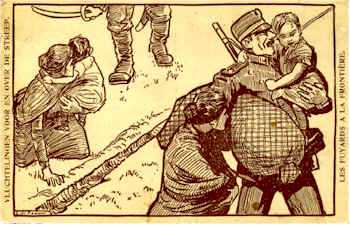 |
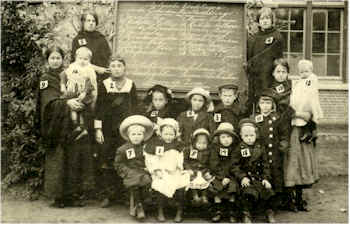 |
Propaganda card with text: Refugees in front of and
across the border (dated: 11 March 1915) |
Abandoned children at Bergen op Zoom.
Photographed in order to find their family |
The civilian refugees were spread out over the entire country and handed over to the
care of the Provincial Refugee committees (Provinciale Vluchtelingencomités). The
soldiers were, if possible in these chaotic circumstances, disarmed and interned; many
military refugees (an estimated 7,000) were able to escape to England wearing civilian
clothes.
As soon as 12 October the negotiation between the Belgian government and the German
occupier started on the return of the civilian refugees. The Dutch government did not
interfere in these negotiations but with gentle insistence tried to return as many
refugees to Belgium as possible. In November 1914 there were still 323,600 refugees
registered; in December 1914 there were 200,000 and in May 1915 there were only 105,000.
This number has approximately remained the same in the Netherlands during the course of
the war.
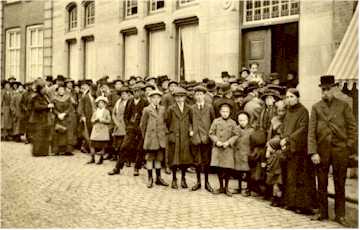 |
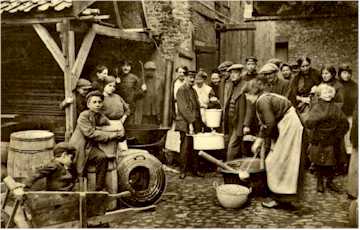 |
Refugees in front of the Dutch Bank
(The Nederlandsche Bank) at Middelburg |
A group of Belgian refugees preparing a meal at Middelburg |
The Dutch government was of the opinion that accommodating the refugees should
initially be a private initiative. Yet, the government was afraid of riots and
manifestations against the Germans. Possibly 'unwanted' foreigners could be turned out of
the country based on the immigration law of 1849 (Vreemdelingenwet 1849).
However, the
government preferred to place these people in guarded camps at Oldenbroek and
Veenhuizen.
These 'prison camps' were closed down in June 1915. The 'criminal' inhabitants still held
there were transferred to a department of Camp Nunspeet that was especially guarded and
fenced off with barbed wire.
At the start of November a solution had to be found for the accommodating of Belgians
that could not be privately housed. In this period the construction of the permanent Camp
Nunspeet was begun. Temporary camps were established at:
- Bergen op Zoom (two camps of tents)
- Roosendaal (the sugar refinery Java could accommodate 1,600 people)
- Tilburg (a camp of tents "Kijk in de Pot" later transferred to a barack camp "Plein XIII"
in May 1915 transferred to Camp Uden, Nunspeet,Ede and Gouda. During the whole
period of the war there was a caravan-camp for Belgian caravan-dwellers in Tilburg.
- Hontenisse (a camp of tents and barracks to hold 4,000 people)
(Camp Hontenisse was closed down in May 1915 and transferred to Camp Uden)
- Baarle Nassau (in the station buildings)
- Oldebroek (in the encampment of Oldebroek; closed down in December 1914)
- Amsterdam (in the pilots of the IJ river)
- Scheveningen (the Circus building)
- Veenhuizen (approximately 1,500 people). This camp was closed down in June 1915
and transferred to Nunspeet. Next to this there were 340 men transferred here that
were released from Belgian prisons when Antwerp was bombed. They were handed
over to the German occupying authorities at the start of 1915.
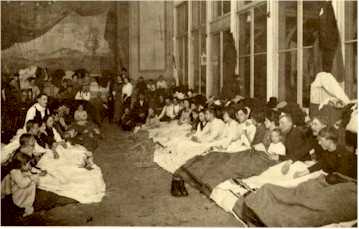 |
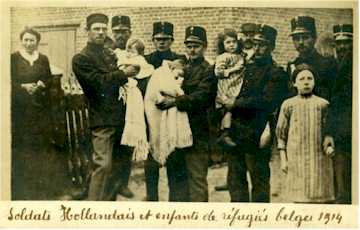 |
| Provisional shelter at Middelburg
in 1914
|
Loving reception of Belgian children by Dutch soldiers
at the Dutch - Belgium border |
From mid-November 1914 the accommodating of refugees in
these ‘camps’ started. Due to the negative connotation
of the word ‘camp’ in official files the word ‘place
of refuge’ was used. In accommodating these people housing
preferably had to ‘match the social status of the
refugee’. Rich Belgians and the so-called Pauvres Honteux
(lit: the silently poor, meaning those of hidden poverty)
were allowed to settle outside of these places of refuge.
Those classified as having hidden poverty even received a
larger benefit (Hfl 0,70 a day for an adult; Hfl 0,50 a day
for a child) than the ‘ordinary poor’ refugees (Hfl 0,35
a day for an adult; Hfl 0,20 a day for a child).
These poor refugees were divided into three categories:
a.
The dangerous or unwanted individuals
b.
The less wanted individuals
c.
The respectably needy individuals
Camp Nunspeet was designed for the first
two categories (for 'the scum of the earth') and was able to
accommodate 13,000 people.
Camp Ede was meant to set an example as a camp and
was designed for category C. This camp could hold 10,000
people. It was closed down in the spring of 1917 and the
remaining inhabitants were taken to camp Nunspeet. The
so-called Danish Village, a section of the camp consisting
of a few mobile abodes which were built at a later stage,
remained in use at Nunspeet. After the war these homes were
taken to Belgium to be of use in the housing shortage due to
war damage.
Camp Uden was erected with categories B
and C in mind and could also accommodate 10,000 refugees.
In Gouda a place of refuge was erected
by the refugee committee to accommodate 2,000 refugees. This
camp was acknowledged by the government as an official place
of refuge in December 1914.
This subdivision in poor/not respectable and rich/respectable refugees was not actually put into practice very
much, but because of it many refugees preferred to return to
Belgium. It was also the reason that the places of refuge
were never completely filled. According to the report of the
Central Committee the number of refugees reached, mainly
consisting of women, children and elderly, in
-
Nunspeet a maximum of 7,050 people
- Ede
a maximum of 5,400 people
-
Uden a maximum of 7,020 people.
Each of these three camps consisted of barracks with a
living room and bedrooms with in addition to these the
facilities that were present in any other village: church,
post office, infirmary, shop, etc.
In March 1915 the Dutch government received a gift of Hfl
325,000 from Denmark (the so-called Danish fund). With this
money workplaces were established in Gouda, Ede and Uden,
where the mobile abodes could be put together. These homes
were placed in:
-
Ede (Deens Dorp) 153 residences [Dorp meaning village]
-
Uden (Villa-Dorp) 154 residences
-
Gouda (placed in Scheveningen)
-
Amsterdam (Alida Jacobsdorp) 27 residences
-
Zierikzee (38 residences meant for Belgian fishermen).
At the end of November 1918 preparations
were made for the repatriation of the refugees still present
in the Netherlands. In January and February 1919 the
inhabitants were returned to Belgium in special trains paid
for by the Dutch government.
Literature:
Literature
on internment and refugees
|